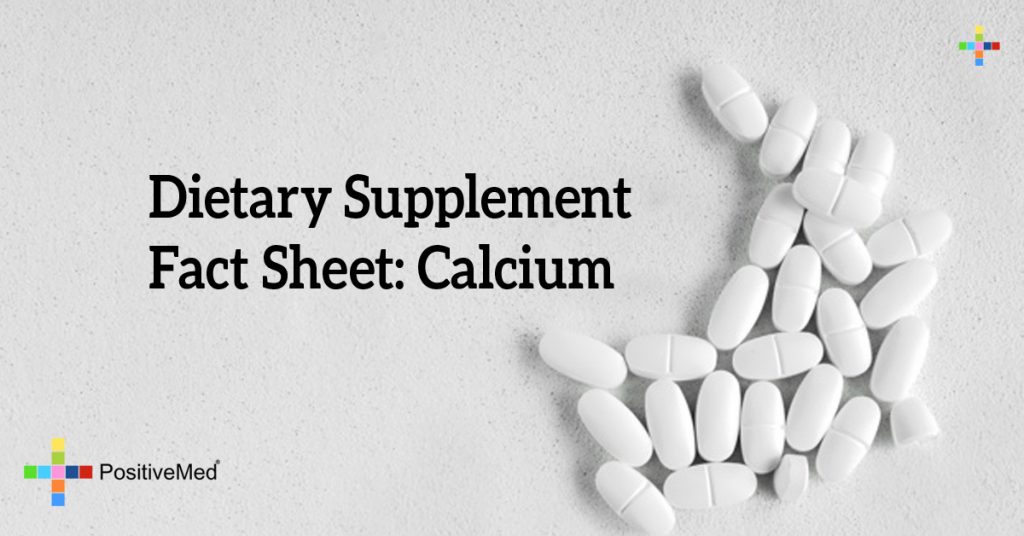
Dietary Supplement Fact Sheet: Calcium
By PositiveMed-Team
Edited By Stephanie Dawson
People should be eating healthier, replacing supplements with food actually containing the nutrients they need rather than popping a multivitamin and assuming that will cover them for the day. That being said, it’s not actually a possibility for a great many people to find fresh fruits and vegetables within their budget. As long as there’s a giant price discrepancy between healthy food and unhealthy food, where people attempting to find 2,000 calories in healthy food will be expected to pay upwards to $35/day for the privilege and those who don’t have that kind of budget can, and will, be able to fund their entire diet for $5/day – as long as they don’t mind additives, preservatives, and a slew of chemicals that damage them internally in ways we’re not even fully aware of, supplements are necessary for many.
Calcium, the most abundant mineral in the body, is found in some foods, added to others, available as a dietary supplement, and present in some medicines (such as antacids). Calcium is required for vascular contraction and vasodilation, muscle function, nerve transmission, intracellular signaling and hormonal secretion, though less than 1% of total body calcium is needed to support these critical metabolic functions. Serum calcium is tightly regulated and does not fluctuate with changes in dietary intake; the body uses bone tissue as a reservoir for, and source of calcium, to maintain constant concentrations of calcium in blood, muscle, and intercellular fluids.
The remaining 99% of the body’s calcium supply is stored in the bones and teeth where it supports their structure and function. Bone itself undergoes continuous remodeling, with constant resorption and deposition of calcium into new bone. The balance between bone resorption and deposition changes with age. Bone formation exceeds resorption in periods of growth in children and adolescents, whereas in early and middle adulthood both processes are relatively equal. In aging adults, particularly among postmenopausal women, bone breakdown exceeds formation, resulting in bone loss that increases the risk of osteoporosis over time.
Intake recommendations for calcium and other nutrients are provided in the Dietary Reference Intakes (DRIs) developed by the Food and Nutrition Board (FNB) at the Institute of Medicine of the National Academies (formerly National Academy of Sciences). DRI is the general term for a set of reference values used for planning and assessing the nutrient intakes of healthy people. These values, which vary by age and gender, include:
The FNB established RDAs for the amounts of calcium required for bone health and to maintain adequate rates of calcium retention in healthy people. The table below illustrates the daily recommended allowances for calcium, divided by age.
Dietary Recommendations for Calcium
Age Group
Dietary Recommendations (mg/day)
0-6 months
210 mg
7-12 months
270 mg
1-3 years
500 mg
4-8 years
800 mg
9-18 years
1300 mg
19-50 years
1000 mg
51 years and older
1200 mg
For adults (including women who are pregnant or breastfeeding) and for children age 1 or older, the safe upper limit of calcium intake is 2.5 grams (or 2500 mg) per day. The U.S. Department of Agriculture’s 1994–1996 Continuing Survey of Food Intakes by Individuals showed that the average daily calcium intakes in the United States for males and females over age 9 were 925 mg and 657 mg, respectively, or less than the recommended intake

Unwanted side effects such as bloating, gas, and constipation are common. Very high doses of calcium can cause kidney stones, dry mouth, nausea, abdominal pain, and irregular heartbeat. Research in 2010 found an increased risk of heart attacks and strokes in some people taking calcium supplements in addition to a diet high in calcium, though the true accuracy of these findings is being actively debated by experts. People with kidney disease, heart problems, sarcoidosis, or bone tumors should not take calcium supplements unless their doctors suggest it.
Calcium deficiency is a serious matter and can lead to osteoporosis and even death. Those most at-risk for calcium deficiency include people who are postmenopausal, amenorrheic, athletes, lactose intolerant or with a cow’s milk allergy, and, somewhat surprisingly, vegetarians. Vegetarians might absorb less calcium than omnivores because they consume more plant products containing oxalic and phytic acids. Lacto-ovo vegetarians (who consume eggs and dairy) and non-vegetarians have similar calcium intake, however vegans, who eat no animal products and ovo-vegetarians (who eat eggs but no dairy products), might not obtain sufficient calcium because of their avoidance of dairy foods.
If you take any prescription or over-the-counter medicines regularly, ask your doctor if it’s safe to use calcium supplements. Calcium can interact with drugs for heart disease, diabetes, epilepsy, and other conditions. Excessive doses of vitamin D can result in dangerously high levels of calcium. High doses of calcium can also interfere with the absorption of other minerals, like iron and zinc. In general, take calcium one to two hours apart from other supplements or medications. When taken at the same time, calcium can bind those products and pass them unabsorbed from the body.

Calcium is found in many foods. Foods high in calcium include dairy products, dark green vegetables, some soy products, fish, nuts, and legumes.Try eating a variety of foods, including the following:
Milk, yogurt, and cheese are the main food sources of calcium for the majority of people in the United States.
Kale, broccoli, and Chinese cabbage are fine vegetable sources of calcium.
Fish with soft bones that are edible, such as canned sardines and salmon, are good animal sources of calcium.
Most grains (such as breads, pastas, and unfortified cereals), while not rich in calcium, add significant amounts of calcium to the diet because people eat them often or in large amounts.
Calcium is added to some breakfast cereals, fruit juices, soy and rice beverages, and tofu. To find out whether these foods have calcium, check the product labels.
SOURCES
Calcium and Cancer, Cancer (dot) Gov – http://www.cancer.gov/cancertopics/factsheet/prevention/calcium
Dietary Supplements – Calcium, Office of Dietary Supplements – http://ods.od.nih.gov/factsheets/Calcium-HealthProfessional/
Calcium Quick Facts, Office of Dietary Supplements – http://ods.od.nih.gov/factsheets/Calcium-QuickFacts/
Calcium and Vitamin D…, ANI News – http://www.aninews.in/newsdetail10/story117915/calcium-and-vitamin-d-supplements-improve-bone-health-after-menopause.html
Calcium Supplements, Mayo Clinic – http://www.mayoclinic.com/health/calcium-supplements/AN01428
Calcium…, WebMD – http://www.webmd.com/vitamins-and-supplements/lifestyle-guide-11/supplement-guide-calcium
Calcium Supplements, MedlinePlus – http://www.nlm.nih.gov/medlineplus/ency/article/007477.htm





